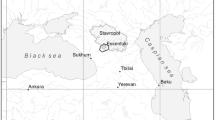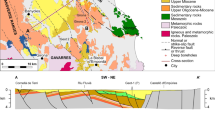Abstract
The mineral water deposits in Kiseljak are located in the central Dinarids, Bosnia and Herzegovina, in the southwestern edge of Sarajevo–Zenica basin that was formed in the zone of Busovača fault. Busovača fault reaches deep into the Earth’s crust and is characterised by the presence of mineral and thermomineral water enriched with CO2 and CO2 springs (mofetes) in the direction of Ilidža–Kiseljak–Busovača. Deposits are constructed of layers of Palaeozoic to Cretaceous age. Primary aquifer of mineral waters is Permian clastites and evaporites and secondary Anisian carbonates. Mineral water and CO2 are of different origin. The water is of atmospheric origin. Due to slow circulation, water descends in the primary aquifer where it becomes enriched with CO2 and minerals. Due to high pressure in the primary aquifer mineral water ascends along Busovača fault, mounts into the secondary aquifer and rises at spring sources. Water is a mixture of two or more waters of different mineralization. Mixing of water occurs in the zone of secondary aquifer even at greater depths without the influence of contemporary climatic factors. Intensive water mixing is indicated by the high ratio of Ca/Sr, Na/Cl and Ca/SO4 and the mixing diagram. CO2 is thermometamorphic, arising from the catalytic activity of SiO2 on carbonates in the deeper layers of the Earth’s crust, where quartz porphyry broke through Palaeozoic formations.









Similar content being viewed by others
References
Bogomolov G, Silin-Bekchurin A (1955) Special hydrogeology (in Russian). Gosgeoltechizdat, Moscow
Born SM, Yanggen DA, Zaporozec A (1987) A guide to groundwater quality planning and management for Local Governments. Wisconsin Geological and Natural History Survey, Madison, Special Report 9:91
Buljan M (1962) New geochemical method of distinguishing the varieties of natural waters. Croatica Chemica Acta 34:13–23
Ceron JC (2000) CO2-rich thermomineral groundwater in the Betic Cordilleras, southeastern Spain: Genesis and tectonic implications, Hydrogeol J 8–2, pp 209–217, Springer-Verlag, Germany
Clark I, Fritz P (1997) Environmental isotopes in hydrogeology. Lewis, New York
Craig H (1961) Isotopic variations in meteoric waters. Science 133:1702–1703
Craig H (1963) The isotopic geochemistry of water and carbon in geothermal areas. In: Nuclear Geology in Geothermal Areas. Gonsiglio Nazionale de lle Ricierche, Laboratorio di geologia Nucleare, Paris
Đerković B (1971) Geological and hydrogeological relationships of the central Bosnia, Special edition Geological Bulletin, Book 10, pp 90–121. Institute for Geological Research, Sarajevo
Drever JI (1997) The geochemistry of natural waters, 3rd edn. Prentice Hall, New Jersey, p 436
Edmunds WM, Cook JM, Darling WG, Kinniburgh DG, Miles DL, Bath AH, Morgan-Jones M, Andrews JN (1987) Baseline geochemical conditions in the Chalk aquifer, Berkshire, UK: a basis for groundwater quality management. Appl Geochem 2:251–274
Garcia MG, Hidalgo MD, Blessa MA (2001) Geochemistry of groundwater in the alluvial plan of Tucuman province, Argentina. Hydrogeol J 9:597–610
Gavrilenko ES (1965) Hidrohemijski pokazatelji naftonosnosti po sonom i izotopskom sastavu podzemnih voda. Akademija Ukrajinske SSR, Kijev
Gonfiantini R, Frohlich K, Araguas-Araguas L, Rozanski K (1998) Isotopes in groundwater hydrology—isotope tracers in catchment hydrology. In: Kendall C, McDonnell JJ (eds). Elsevier Science B.V., pp 203–246
Hem JD (1985) Study and interpretation of the chemical characteristics of natural water. Washington: US Geological Survey Water—Supply Paper 2254
Hrvatović H (2006) Geological guidebook through Bosnia and Herzegovina. Federal Department for Geology, Sarajevo
IAEA (1983) Guidebook on Nuclear Techniques in Hydrology. Technical report Series No.91. International Atomic Energy Agency, Vienna
Josipović J (1971) Mineral, thermal and thermomineral waters of Bosnia and Herzegovina, Geological Bulletin Book 15. pp 233–275. Sarajevo
Jovanović R, Mojićević M, Tokić S, Rokić Lj (1978) Basic geological map 1:100,000, map sarajevo explanatory book. Federal Geological Department, Beograd
Katzer F (1919) Contribution to the knowledge of Bosnian mineral wells, Bulletin of the National Museum of Bosnia and Herzegovina. Zemaljska štamparija, Sarajevo, pp 191–264
Lecher K (1982) Stochastik in der Hydrologie. Taschenbuch der Wasserwirtschaft. Paul Parey Verlag, Hamburg/Berlin, pp 241–266
Ludvig E (1893) Mineral water springs of Bosnia, geological annals of Balkan Peninsula, Book 4. Beograd, pp 244–278
Miholić S (1957) Bosnian mineral water springs, II Yugoslav Geological Congress. Sarajevo, pp 599–601
Miholić M, Mirnik K (1957) Contribution to the knowledge of Bosnian mineral water springs, Geochemical study, Croat Chem Acta 29, Zagreb
Miošić N (1982) Classification of mineral, thermal and thermomineral waters of Bosnia and Herzegovina, Geological Bulletin, Book 27. Geoengineering, Sarajevo, pp 221–258
Muffler P, White D (1968) Origin of CO2 in Salton Sea geothermal systems, southeastern California, USA. 23rd Int Geol Cangr. Prague, 17
Piper AM (1953) A graphic procedure in the geochemical interpretation of water analysis. US Geological Survey Groundwater, Note 12
Skopljak F (2006) Groundwater interrelations of Ilidža near Sarajevo, PhD thesis, Special edition Geological Bulletin, Book 29, Federal Department for Geology, Sarajevo
Skopljak F, Bašagić M (2004) Comparision of mineral water springs „Meso-Impex” in Brestovsko near Kiseljak and mineral water springs “Sarajevski kiseljak” in Kiseljak. Department of Geology and Geotechnics, Faculty of Civil Engineering, Sarajevo
Škripić N, Skopljak F (2007) Classification and categorization of mineral water reserves in „Sarajevski kiseljak”-Kiseljak. Department of Geology and Geotechnics, Faculty of Civil Engineering, Sarajevo
Slišković I (1998) Potentials of mineral, thermal and thermomineral waters of central Bosnia. Croatian Waters 25:375–381
Stallard RF, Edmond JM (1987) Geochemistry of the Amazon 3. Weathering chemistry and limits to dissolved inputs. J Geophys Res 92:8293–8302
Sulin VA (1948) Basis of Classification of Natural Waters. USSR, Moscow
Vlahović T (2000) Hydrogeochemical Characteristics of the Sv. Ivan Spring in Istria, Croatia. Rudarsko—geološko—naftni zbornik, 12, 29–36, Zagreb
Vlahović T, Bačani A, Posavec K (2009) Hydrogeochemical stratification of the unconfined Samobor aquifer (Zagreb, Croatia). Environ Geol 57(8):1707–1722
Author information
Authors and Affiliations
Corresponding author
Rights and permissions
About this article
Cite this article
Skopljak, F., Vlahović, T. The origin of mineral waters in Kiseljak near Sarajevo, Bosnia and Herzegovina. Environ Earth Sci 66, 809–822 (2012). https://doi.org/10.1007/s12665-011-1290-7
Received:
Accepted:
Published:
Issue Date:
DOI: https://doi.org/10.1007/s12665-011-1290-7




